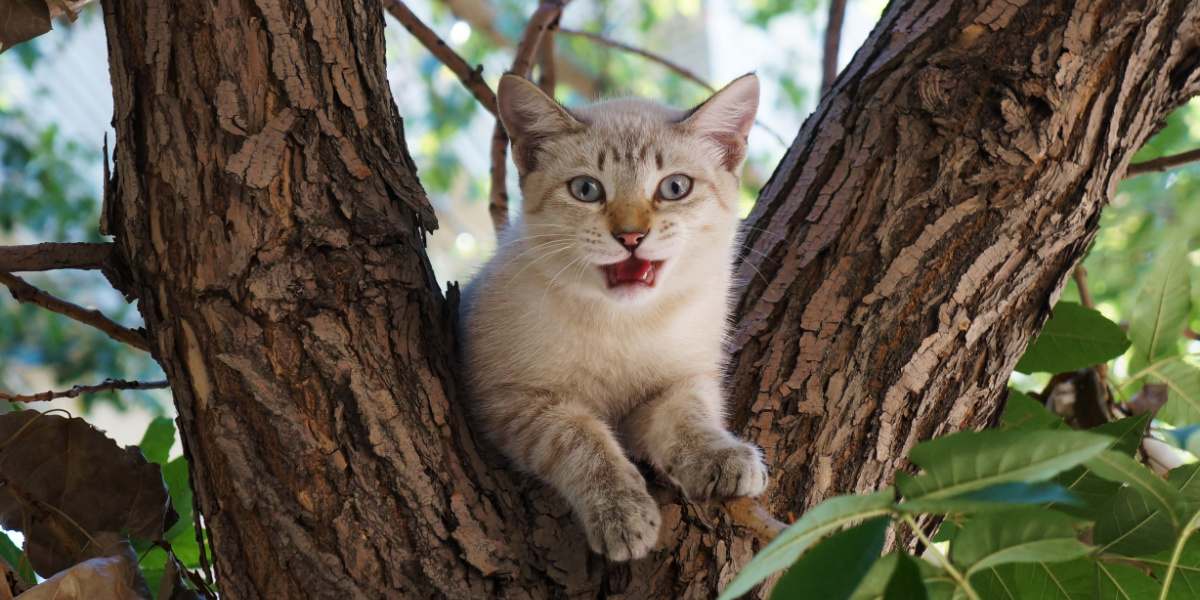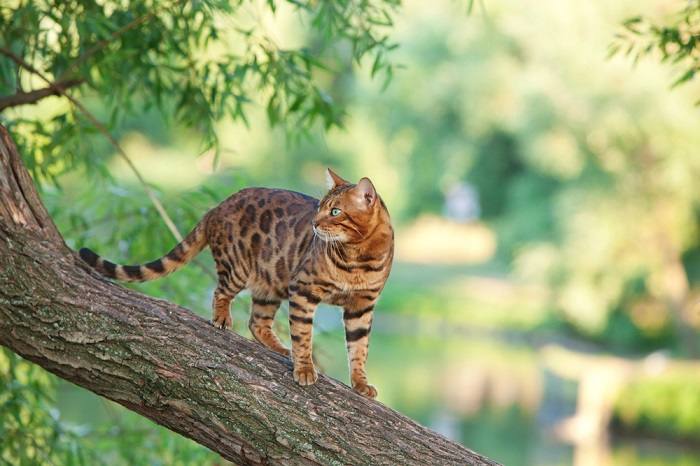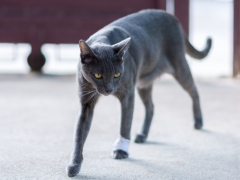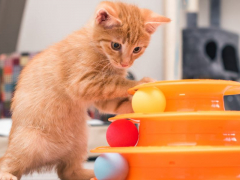
One of my earliest memories is of my gorgeous childhood cat Tigger going missing overnight. Thankfully, his plaintive cries were heard by neighbors, and he was discovered stuck up a tree in nearby woodland. After attempts to entice him down failed, our wonderful local fire department saved the day and rescued him!
Given that cats are such good climbers, you might be wondering why is it relatively common to hear reports of them not being able to climb down trees and getting stuck. In this article we will discuss why cats get stuck in trees, and what you should do if it happens to your pet.
Why Do Cats Climb Trees?
Cats have an instinctive desire to be up high, as lofty locations provide safe resting spots, and are also great vantage points to survey their surroundings for danger and hunting opportunities.
Cats might flee up trees to escape threats such as larger predators or might end up high in the treetops after chasing prey. Some cats seem to enjoy climbing trees to satisfy their curious natures and explore their environment.
Are Cats Good Climbers?
Members of the cat family are well adapted for climbing trees—their extendable claws allow them to grip onto the tree trunk as their powerful rear legs push them upward. Although many species of large wild cats like lions and tigers rarely climb trees, some smaller wild cat species spend most of their time in the treetops.
The problems for tree-climbing cats might begin when they want to get down. You might have noticed that your cat usually jumps down from heights rather than climbing. Cats are excellent at landing on their feet but they can hurt themselves if they jump from extreme heights.
Unlike certain animals like squirrels (which your cat might have chased up the tree in the first place), most cats are unable to descend trees headfirst. Feline claws are great for climbing up trees, but they face the wrong way to go down trees headfirst, meaning the cat can’t steady itself. Consequently, cats have to either jump or clamber down the tree trunk backward.
Also Read: 5 Simple Tips To Keep Cats Off Counters
Can Any Cats Climb Down Trees?
Interestingly, there are just three species of arboreal wild cats that have special adaptations allowing them to descend trees headfirst: margays, marbled cats, and clouded leopards. These cats have ankle joints on their hind legs that can rotate up to 180 degrees, as well as other adaptations like large paw pads, that enable them to easily navigate their treetop environments.
Why Do Cats Get Stuck Up Trees?

Sometimes cats get stuck in trees because they don’t know how to get back down, but other times they are simply scared to go back to the ground.
Chasing prey, fleeing from dangers such as dogs, or getting carried away with exploring can all lead to a cat being too high up in a tree to jump down without risking injury. Not all cats seem to realize that they need to descend trees backward if they are too high to safely jump down, so some of them get stuck.
Sometimes cats might appear stuck when they are actually just scared that there is still danger present, making staying up the tree the most appealing option to them.
Cats that have been declawed are usually kept indoors, but if they escape and climb a tree they are particularly likely to get stuck. Despite their lack of claws to help, they are usually able to climb up trees but are not able to grip to descend them backward.
Declawed cats are also likely to be terrified if they are not used to being outdoors, and might decide it‘s safer to stay up high in a tree. Declawing is mutilation, and this is another reason it is never recommended for our feline companions.
Also Read: 6 Cat-Friendly Alternatives To Declawing
How Do I Know if My Cat Is Stuck in a Tree?
Cats will be fine without food and water for several hours, but if they are stuck up a tree for too long they will begin to get hungry, dehydrated, and exhausted. The following are signs that your cat is stuck up a tree, rather than being there by choice:
- They have been in the tree for several hours, or overnight.
- They are showing obvious signs of distress such as meowing, yowling, and pacing.
- They keep attempting to jump down but stop at the last moment.
What To Do if Your Cat Gets Stuck up a Tree
First, don’t panic! Cats are excellent climbers and it would be very rare for them to fall out of a tree. If you appear worried and stressed, it might make your cat even more anxious about coming down from the tree. Most cats will eventually figure out how to get down, so just give them some time and space.
Have a good look around the area to see if there is anything that could be frightening your cat and stopping them from coming down. Removing what they perceive as a threat, or waiting until everything has gone quiet and dark, might be all that is needed for your cat to pluck up the courage to descend on their own.
Call your cat in a calm, soothing voice to encourage them back to ground level. You could put some blankets, cushions, or a mattress on the ground under the tree to provide a soft landing for your cat to jump onto. Try tempting them with their favorite treats, or some enticing food that they will be able to smell from a distance like a tuna. Another option is to guide them along a safe path down the tree using a toy (if you can reach) or a laser pointer.
Some people suggest hoisting a cat carrier (using a rope over a branch) with some tempting treats or cat food in it to encourage the stranded cat in, and then lowering the carrier to the ground. This method should be avoided as it risks injury to the cat if the box tips or they fall trying to get into the unstable carrier.
Can I Climb Up to Rescue My Cat From a Tree?

In some situations you might be able to climb a ladder to retrieve your cat, but take extreme care so you don’t injure yourself or your cat.
If the above methods to encourage your cat down from the tree fail, it may be tempting to get a sturdy ladder and climb up to rescue them yourself, but this is potentially dangerous for both you and your cat, and ideally should be left to professionals. Only climb up a ladder if you are physically able to, have the correct equipment, and have someone to assist you.
Be aware that your cat might be scared and retreat even further up the tree, especially if a stranger climbs up to them. It is sensible to take precautions such as wearing long sleeves and gloves in case the cat panics and scratches you. Take a carrier up the ladder with you and try to secure your cat in it before you climb down, to avoid them struggling in your arms and leading to either of you falling.
Despite traditional scenes in movies of the fire department rushing to rescue hapless cats from trees, these days most fire departments are unable to help in this situation as they are overstretched, and need to be available for human emergencies.
Calling your local animal shelter or rescue organization for help is a safer option for you and your pet as they should have direct experience of rescuing cats from trees, or be able to advise you of someone local to call. Catinatreerescue.com has a worldwide directory of climbers (such as tree surgeons) you can contact for help if your cat is stuck up a tree.
Final Thoughts
Cats are athletic, agile creatures who are adept at climbing up trees thanks to their curved claws and strong back legs. Although some wild cats have adapted to be able to climb down trees headfirst, domestic cats are unable to do this and must either descend trees backward or jump down to the ground. If excitement, chasing prey, or fleeing from danger have made a cat inadvertently climb too high up a tree, they might get stuck, and be unable to get back down.
Most cats will find a safe route to the ground with time, so it is important not to panic if your cat appears to be stuck. Treats, toys, or even a laser pointer can be used to try and coax them down to safety. If this is unsuccessful call for help from an experienced animal rescue organization, or climbing professional, rather than attempting to climb up the tree and rescue your cat yourself.
Also Read: Should I Let My Cat Outside?
Frequently Asked Questions
How do I stop my cat climbing up trees and getting stuck?
Your best bet for keeping your cat out of mischief is to keep them indoors where the only tree they should encounter is your Christmas tree! Indoor cats are also protected from fights with other cats and being involved in road traffic accidents. Another option is to limit their access to any tall trees by building a safe cat-proof outdoor enclosure. You can purchase a cat tree to allow your cat to exercise their natural climbing behaviors safely indoors.
If your cat does go outdoors ensure that they are wearing a quick-release collar (or consider them going collarless) so that they don’t get caught on a branch while climbing.
Can cats climb down trees headfirst?
Although there are a few wildcats, such as the clouded leopard, with particularly flexible hind-limb joints that enable them to climb headfirst down trees, domestic cats are unable to do this and have to jump down or descend backward.
What do I do if my cat is stuck in a tree?
First, don’t panic. Cats are great climbers and are very unlikely to fall out of a tree. Look for signs like yowling or meowing to confirm that your cat is definitely stuck, and not just exploring or resting. Try to tempt your cat down with gentle encouragement, tasty food, or a toy, and consider putting a mattress or cushions under the tree to provide a soft landing so they feel more confident to jump down.
If this doesn’t work, contact your local animal rescue organization, or someone with appropriate equipment and climbing experience like a tree surgeon, to help you rescue your pet (rather than risk your safety trying to climb the tree yourself).
-
petmd.com
-
wildcatconservation.org
-
https://nationalzoo.si.edu/animals/clouded-leopard







